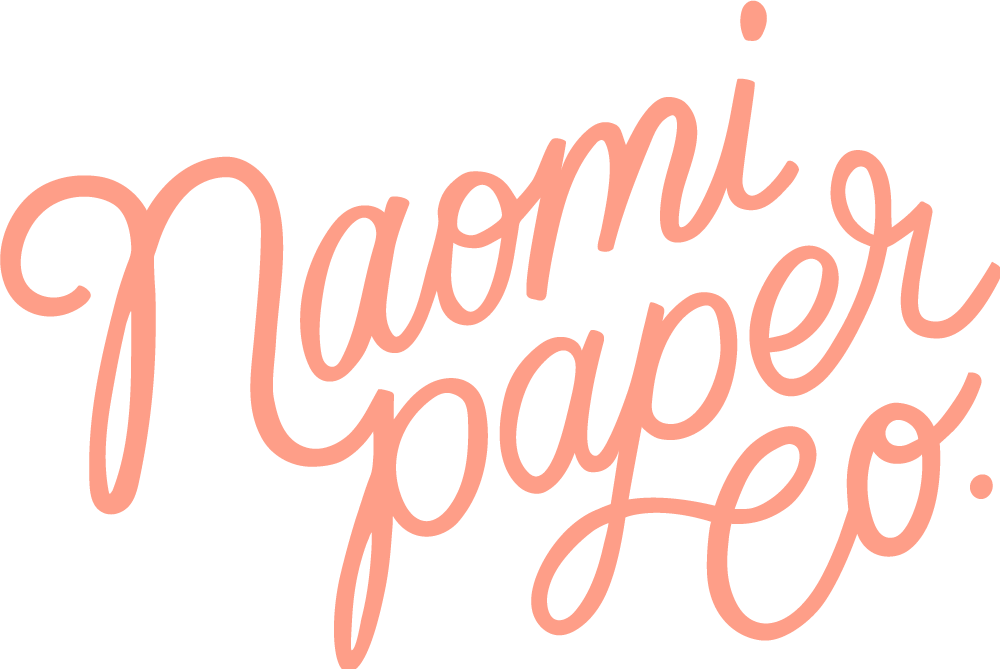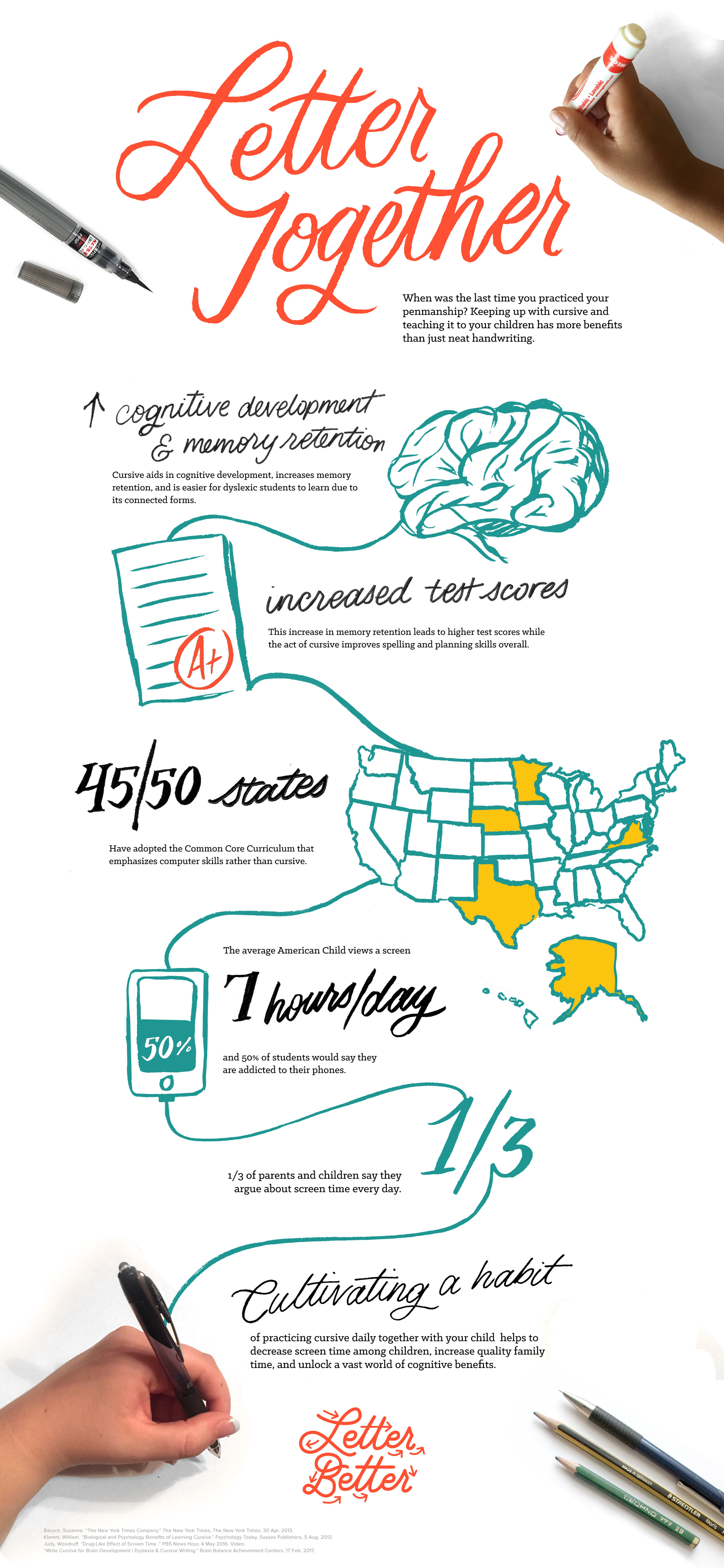Why Cursive Handwriting Still Matters (and what we can do about it)
Here at Naomi Paper Co. I've built my entire career on hand lettering: creating one-of-a-kind prints, wedding invites, logos, and more. What makes my work unique is that each and every piece is written in my own hand.
This hand-made quality draws people into my work because even in this growing age of technology, I think we all crave human connection that cannot be replicated by any digital tool.
My love for hand lettering can be traced back to when I first learned cursive in 3rd grade at my public school. So I was shocked when I heard that my nine year old niece wouldn't be learning cursive at all— not even how to sign her own name!
I asked myself the same question you're probably thinking: why does it even matter?
My personal bias aside, I found there are numerous reasons why penmanship and cursive are still valuable skills to develop, perhaps now more than ever.
1. Increased cognitive development
Screens continue to be introduced to children at younger and younger ages. While videos and games can entertain/distract a child, they do little to actually engage their brains at a young age.
Mark Mon-Williams, Professor of Cognitive Psychology, writes that "the physical act of handwriting requires children to learn to control the force they apply to objects held in their hands. It requires the use of visual feedback to correct errors and the ability to make predictions about the consequences of the commands the brain sends to the hand. These are fundamental control processes required in many other situations – think of using cutlery, tying shoelaces and playing ball sports for example."
Handwriting aids in cognitive development by activating multiple areas of the brain, because our brains learn best when engaging more than one sense in combination with physical movement.
2. Improved memory retention
Memory retention is one of the greatest and most scientifically proven benefits to handwriting.
One of the most common uses of handwriting is note taking in class. Today, if you're sitting in a lecture hall or classroom, most students will pull out their laptops to take notes.
When doing this, however, the student typically writes down each word verbatim, rather than writing things down in their own words. This method of note taking essentially only engages your finger muscles as you type, and little else.
Since handwriting takes longer than typing, students are forced to process the information differently. This process actually engages multiple parts of the brain as they listen, interpret, and formulate how to write the information down in their own words in a short amount of time.
While typing, each word that you type feels exactly the same. In handwriting, though, each letter and word has its own unique set of movements. This added muscle movement calls on additional areas of the brain.
Cursive is also closely related to drawing with its flowing lines. This can make note taking an almost pictorial experience, and easier for visual learners (such as myself) to recall back the information by visualizing their notes on the page.
3. Better spelling & overall planning skills
Writing with a pencil and paper offer no undo button or spellcheck, crutches that can inhibit a student's ability to learn how to spell. This is a dangerous skill to lose sight of considering that a lack of spelling skills can be strongly linked to a lack of reading and comprehension skills. Through handwriting, students learn from their spelling mistakes more effectively.
Cursive makes it even harder for a student to go back and fix a mistake due to the many unique ways that each letter connects to the next. In regular printing, each letter acts independently to form a word, and is easily interchangeable with one another. In cursive, however, the letters are physically connected, since the end of each letter actually creates the beginning of the next.
Cursive not only teaches children better spelling skills, but also better planning skills as they must think ahead to avoid making mistakes.
4. Increased test scores
It comes as no surprise then, that through increased cognitive development, improved memory retention, and better spelling and planning skills, students who regularly practice cursive handwriting are naturally prone to receive higher test scores.
there are more than just educational benefits to cursive handwriting,
which may be the most compelling of all (in my opinion).
5. it connects children to their ancestry
My grandma's legacy has always been her sense of humor and amazing food. She would invent and write her own recipes, or cut ones out to add her own notes to them.
Every Christmas, we gather as a family for a couple of days to bake (literally) thousands of cookies. It's the one remaining family tradition we practice today, and each and every year, we pull out the same set of recipe cards written in my grandma's own hand— nearly all in cursive.
As I asked my niece to read the next directions of the recipe, it became clear we would need a translator to read what was written in plain english.
Cursive looked like a foreign language to her. Though she's an avid reader, her eyes panicked at the sight of this different style, and couldn't connect or understand what her great grandma had written years ago.
Yes, we could re-type the recipe cards, but something would be lost. After we typed up the Declaration of Independence, did we throw out the original? That may seem like an extreme example, but the concept is the same. Family history has a way of shaping our identity, the same way that American history does too. It's something to be preserved.
Our family history, traditions, and love are found in these handwritten recipe cards, and forgetting cursive means forgetting a piece of my grandma's legacy for generations to come.
I know I'm not alone in this love for the tangible. It's the reason vinyl records are back in style, why Polaroid has revived its original camera and film, and why companies like Artifact Uprising have made their debut in the past 5 years.
We crave the tangible again.
An excerpt from my Bible in a Year Little Lettering project in my own Bible, updated daily on our Instagram.
6. it's a tool for scripture memorization
When you browse my work it's pretty clear that I'm a believer, and hand lettering actually plays a significant role in my testimony.
As Christians, one of the greatest weapons and tools we can carry with us at all times is the Word of God. We use it as comfort in times of trouble, encouragement in times of despair, defense in the face of temptation, and truth in the face of lies.
The best news is that we can use the same memory retaining benefits of handwriting for more than just class notes or meeting notes at work. We can use it to better understand & remember sermons, write down prayers, and as a tool to memorize passages of scripture.
When I create my hand lettering pieces, I typically draw/write the verse a minimum of 15 times. Because of this, I can tell you that I have memorized each and every Bible verse of which I've created a hand lettering piece.
In each rendition, I'm constantly trying to combine the meaning of the verse with the style of lettering I choose. There's something about the truth that "He is before all things, and in him all things hold together" (Colossians 1:17), that has me consistently coming back to cursive. His Word is the line that connects each individual letter in our lives and holds all things together.
We can use cursive and hand lettering to experience the abundance of God's Word in our lives.
so if cursive is dying, what can we do about it?
You and I can teach cursive to our children (or nieces and nephews and cousins and students), and develop new habits of practicing it ourselves.
With the assumption that fewer and fewer schools are going to continue to teach cursive, we've been working to develop a hands-on interactive game to introduce children to cursive handwriting in your own home (and perhaps refresh your memory too).
Letter Better is an interactive memory game that introduces children (ages 5-12) to cursive handwriting by matching the cursive form of a letter with the printed form. And since the cards are laminated, children can use a dry erase marker to practice each letter an unlimited amount of times!
Playing Letter Better creates familiarity with the cursive letterforms and helps increase memory retention at the same time. Letter Better also aims to encourage hands-on family time over screen time through playing the game together.






